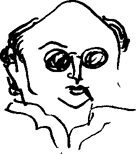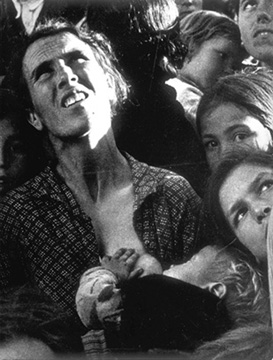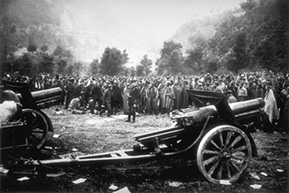
Drawing by Carlo Levi

Chim greeting Henri Cartier-Bresson. Paris, 1937. Photographer unknown.
�1996 from the Estate of David Seymour

Land distribution meeting. Estremadura, Spain, 1936
�1996 from the Estate of David Seymour

Picasso in front of his picture, Guernica at its unveiling at the Spanish Pavilion of the World’s Fair. Paris, 1937
�1996 from the Estate of David Seymour

Troops wearing gas masks during airraids. Barcelona, 1936
�1996 from the Estate of David Seymour

As soldiers crossed the border at Le Perthus, they were required to hand over their weapons before entering France.
The arms were later given to General Franco. 1939
�1996 from the Estate of David Seymour
|
In February of 1935, the five-year-old Spanish Republic voted in a
Popular Front government by a small majority, similar in concept to
the coalition then electioneering in France. French conservatives
worried how this new government would deal with the issues
confronting it; they feared developments in Spain would affect their
own fate under a Popular Front regime.
"Our Special Correspondent Chim" was sent to Spain by Regards
to report on crucial issues there. He found that the problems of Spain
were unique to that country, shaped by its own history and tradition.
He also found the country divided and passionate in its differences.
Land distribution was one of the most pressing problems on the
agenda of the Spanish Popular Front. Especially in the south and
southwest, absentees owned almost all the land. There, the landless
farmers were virtually indentured. Chim traveled to the impoverished
province of Estremadura, where sixty thousand peasants had
occupied fallow lands.
In July 1936, when the officer corps instituted a widespread
coup, the elected government immediately appealed for help to its
brother Front Populaire under Leon Blum. But France was allied with
England, whose leaders feared intervention would provoke yet
another world conflagration. Against his better judgment, Leon Blum
joined England in a non-intervention pact. As head of the insurgents
who had engineered the coup against the Spanish government, Colonel
Francisco Franco immediately appealed to fascist Germany and Italy
for help. They sent massive supplies of troops and materials. The
Soviet Union feigned neutrality, but sent experienced soldiers and, in
exchange for Spanish gold, outdated military equipment.
The Republican forces were made up of the general population of
agricultural and urban workers. Untrained as soldiers, they did their
best with World War I guns and rifles, and whatever the government
was able to buy from arms smugglers in Paris. Enthusiasm for the
cause was the only commodity running high. Idealistic young men
from many countries traveled to Spain to fight in the International
Brigades.
Chim returned to Spain in August 1936, a month after the
outbreak of war, and proceeded to the front in the foothills near the
Spanish city of Irun, where he immediately saw action.
Andre, now bylined Robert Capa, and his photographer girlfriend,
Gerta Taro, had arrived in Spain and were photographing where the
action was hottest. Chim was now obliged to wear glasses, which
made him vulnerable, even useless, in action. He therefore
concentrated on exclusive stories telling the world about the
defenses that backed up the Republican cause. Together, they formed
a perfect team: what Capa and Taro contributed in passion at the
front, Chim made up in thoughtfulness and compassion behind the
scenes. On highly secret missions, which required both
trustworthiness and discretion, Chim photographed munitions and
aircraft factories. He photographed parts of Republican Spain not yet
under fire, but strategically important and bound to be attacked soon,
as indeed they were: vital Catalan factories, Basque fishing boats,
Basque soldiers enjoying moral support from monks at the Monastery
of Amorabita and attending an outdoor mass before going into battle,
and priests providing the rites of burial within the church.
When Chim returned to Asturias, to the much admired miners he
had visited before the war, Regards headlines announced "World
Wide Scoop, Sensational Photographs! CHIM with the miners in the
trenches under Oviedo."
Capa was in Paris when news came that Gerta Taro had been
accidentally killed in Spain. She was twenty-six years old. The
sympathetic press, which was attended by thousands, turned her
funeral into a political event. This time the cause was solidarity with
Republican Spain.
Chim was now well aware of the divisiveness among Socialists,
Communists, Anarchists, and Trotskyites who made up the Republican
forces. On the insurgent's side, German and Italian troops, with their
advanced weapons and many airplanes, had reduced the chances of
victory for Republican Spain. Barcelona was bombed regularly. Chim's
essay on that city appeared in LIFE Magazine in New York. After the
retreat on the Ebro river in December, 1938, Nationalist forces
pressed on into Catalonia. Citizens and soldiers now fled toward
France.
By mid-May the war was over; Republican Spain was defeated.
It was the end of an era, not only for Chim, but for all Europeans, and
Americans, though they did not know it yet the end of Europe's noble
effort to become a continent of democracies.
Chim was now twenty-eight years old. The five years in France
and Spain had been his formative years, not only as a photographer,
but emotionally and intellectually.
Chim was now a thoroughly seasoned photojournalist. Twenty-
five of his stories on Spain had been published in Regards. Far from
his editors in Paris, he had had the opportunity to pick his own story
ideas and provide the necessary text for them.
- Inge Bondi
� 1996, Inge Bondi
from CHIM: The Photographs of David Seymour, Bulfinch Press/Little, Brown and Company
|





































